|
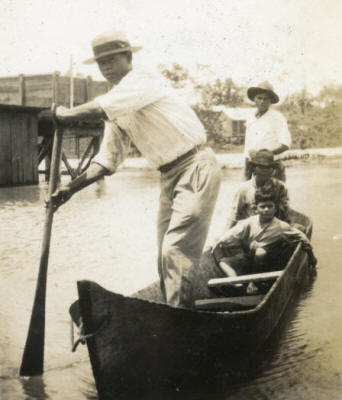 THIS IS THE FIFTH PAGE
of documents for the FIRST HALF of 1932
on Nicaragua's Caribbean Coast
region, housing documents dated in the 34 days from May
28 to June 30.
THIS IS THE FIFTH PAGE
of documents for the FIRST HALF of 1932
on Nicaragua's Caribbean Coast
region, housing documents dated in the 34 days from May
28 to June 30.
The dramatic weeklong battle for
control of the mining districts
between the Upper Waspuk and the
Upper Bambana (19-26 May) dominates
the documents on this page, with
gripping & detailed eyewitness
accounts told from multiple angles:
•
Guardia combat reports:
•
Somarriba on 25 May (previous page)
•
Gray
on 27 May (previous page)
•
Gray
on 28 May
•
Curcey
on 31 May
•
Moravian missionaries’ letters &
reports:
•
Heath
on 8 June
•
Danneberger on 9 June
•
Heath
again on 15 June
•
additional letters on adjoining
pages
•
Spy report & declaration of
released EDSN captives:
•
Agustín Rivera spy report of 28 May
•
Damaso
Gómez and Florencio Sáenz
declaration of 30 May
•
Sandino’s letters &
bulletins:
•
Sandino bulletin to Indo-Hispanic
Observers on 18 May (previous page)
•
Sandino letter to Estrada & Morales
on 22 May (previous page)
•
Sandino letter to Estrada on 3 June
The abundance of
sources on these
little-known events is remarkable.
An elaborate study could be crafted
around the events of this week
alone. Upwards of 400-500
Sandinista soldiers joined in the
grand offensive, led by Generals
Pedrón Altamirano and Pedro Antonio
Irías. The struggle hinged on
the EDSN’s determination to dominate
the towns & mines of the mining
districts, and the Guardia’s
determination to keep the mines,
towns & commissaries from falling
into rebel hands. The
offensive seems to conclude without
a clear victory for either side —
though as we learn in later pages,
Pedron & Irias's forces suffer a
huge defeat, with upwards of 60 dead
and utter destitution among the
survivors. Despite the rebels'
grit and resolve, the Guardia’s
superior resources and weapons give
them a decisive military advantage.
Many insights on the unfolding
battle for control of the mining
districts and the Coast as a whole
might be gleaned from these texts.
Further south in
eastern Chontales, armed
groups seemingly independent of the
EDSN pose an ostensible threat to
the commissaries & stores around
Muelle de los Bueyes and El Recreo,
upriver from El Rama on the Río
Mico; the Guardia pushes back and
the group vanishes (El Recreo marks
the limit of unimpeded navigation
upriver; both river towns sit along
a telegraph & telephone line running
east through Rama to Bluefields).
In Bluefields
the political campaigns for the
upcoming November elections are well
underway, with Liberals under Juan
Bautista Sacasa and Enoc Aguado
leading the pack. Meantime
across the region some 200 “cívicos”
(members of civilian auxiliary
militias) buttress the Guardia’s
growing power. Here are the
figures, one of the many gems buried
in these documents:
|
|
Guardia*
|
Cívicos**
|
|
Bluefields
|
70
|
74
|
|
Neptune
Mine
|
25
|
95
|
|
Wuani
|
33
|
|
|
Punta
Gorda
|
4
|
|
|
El Bluff
|
3
|
|
|
El Rama
|
22
|
15
|
|
La Cruz
|
4
|
|
|
El Gallo
|
17
|
10
|
|
Rio
Grande Bar
|
5
|
12
|
|
TOTALS
|
183
|
206
|
| |
|
|
|
* see
Guardia Troop Distribution
tables, May 1932
|
|
**
see 32.06.07 Leech p. 3 on
this page
|
In
other words, the Caribbean
Coast region saw more cívicos under
private contract than members of the
Guardia Nacional — with the
institutionalization of partially
privatized public security forming a
critical part of the rapid & ongoing
transformation of the power & reach
of the national state. The
unfolding events in the mining
districts form one leading edge of
these longer-term shifts.
|
|
PERIOD MAPS
|
|
1894 mosquito
shore

27 MB,
library of congress
|
1920s
Standard Fruit

6.5 mb,
US National archives
|
1928 Rio wanks
Patrol

3 mb, us
national archives
|
1931 Moravian

2.4 mb,
comenius press
|
|
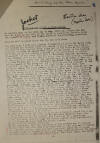
|
28 May 1932.
Declaration of
Don Agustín Rivera, Neptune Mine,
to Commanding Officer GN, p. 1.
"At Neptune Mine
on the 28th day of May, 1932, Mr. Rivera
who was sent as a spy on the 19th of the
month to locate the Bandits under the
command of Pedron and Irias, answered
the following questions: ¶
Tell me what happened since the day you
left here. ¶ The 19th when I
left here because I believed it to be
the worst road, and because the bandits
never had passed on it, I took the road
by the name of “Don Julina” which comes
out at the finca of Don Julian Maireno,
or which is called “Del Tico” in the
region of Rio Bambana. At 9
o’clock in the morning I paused by the
place which is called “Cacaotal” or two
hours from here to Francisco Morales
residence. I was talking with an
old man and until then he know nothing,
although it was generally known that the
Bandits were is La Ceiba. I went
on a little further and in Mr. Eustacio
Cornfield I was surprised by the advance
guard of the enemy but due to ability
and the goodness of God I was able to
flee and hide in the bush behind a big
Ceiba Tree listening while the enemy
passed. A little later they
stopped and one of them returned to look
for the General Pedron who I know
perfectly well and whose voice I
recognized. The soldier spoke to
the General. Things are bad
because we are near the enemy and the
Pedron answered, Aja, Why? Because
here comes a very fresh track in the
road which leads towards the mountains
to which Pedron replied, Man, I wonder
if this couldn’t be the Bandit Agustin,
I do not doubt that he will go to give
information at Tunky but it doesn’t
matter; take care, and they continued
marching leaving me behind. When
the last bandit passed I went through
the bush and not using the road and
later further along I was surprised by
those who were coming behind and they
captured me, but I told them I was on a
mission from Pedron to where Gral. Irias
was, and until then I didn’t know that
General Irias was the one in back of me
and by suppositions at which they let me
pass giving me some soldiers who took me
where the General was, and for a second
time I pulled a fast one on them taking
the bush and coming out at the finca of
Ignacio Iglesias on Rio Bambana.
The wife of Ignacio knew nothing and her
oldest son was not there, I told her
what happened and continued ahead but
only though the bush; a little further
on I saw at the turn of the road other
soldiers coming. At this point I
was very frightened because I believed
that the whole district was infested
with bandits. ¶ I slept in
the bush and very early in the morning I
looked for a way out, and came out at
the home of Mr. Aberlino Martinez where
the bandits had been the day before, and
found him in a lamentable state,
shoeless without clothes and almost
insane, then I suffered a strong attack
of rheumatism and couldn’t’ walk.
¶ Q. What did don Abelino tell
you. ¶ A. The following.
That the intention of the bandits was to
capture Neptune Mines and this time they
would take it, as they were bringing
many men and machine guns, and that they
would leave all in ashes beginning with
the Pineda brother, and they asked
especially for Adrian who they said is
an American sympathizer. That
after taking the Mines . . . "
|
|
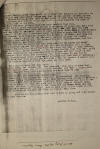
|
28 May 1932.
Declaration of
Don Agustín Rivera, Neptune Mine,
to Commanding Officer GN, p. 2.
". . . and the
Machine guns they would go to Wuani and
capture it, and that he with his own
ears heard Pedron say that he was
neither Abraham Rivera nor Simeon
Gonzales, and that he was going to show
them who was Petron Altamirano, and that
he would cut-------and renounce his name
if he didn’t go to the Mine. ¶
Q. Were you able to ascertain how many
bandits they were. ¶ A. By
what I could calculate by the first
group of people who were with Pedron
they were more than two hundred for I
was very near the road and was able to
estimate more or less and with Irias
were a considerable number, in addition
I obtained exact data from a young man
by the name of Carsamo, whom they had
brought the direction of Wuani, and they
had turned loose at house of Don
Adelina. He told me that his
cousin was with the bandits they had
treated him with consideration, and that
he was able to see everything. ¶
He told me that he estimated that they
were in two bands and about five hundred
men and that Irias had told him
personally that if they entered Neptune
they would pay back what they had done
to them in Sulun, and Biltigni. Irias
boasted to his troops telling them they
were going to eat crackers in the
commissaries very soon and that would be
well clothed, well shod, and furnished
with good women. It was fun to
hear them arrange their plans as if
everyone was tied down or sleeping.
The data that I am giving you although I
was not present I assure that it is
certain because I know the young many
very well. ¶ Q. What kind of arms
did they have. ¶ A. Good
arms, and between the two generals, they
were no less than eight machine guns,
two of them thick barrels and with a
large plate like disk, but very little
ammunition not more than 50 rds. ¶
Q. Why didn’t you come here immediately.
¶ Because it was impossible on
account of rheumatism and secondly
because it was impossible for me to pass
through this circle of Bandits.
But I did sent Santos Salgado to advise
and he immediately went to see in which
direction they had gone, and he also
sneaked through their boards, but when
he arrived at his house and met Ramon
Cruz, who was going as a messenger to
Wuani, and he went back to the Mines to
give them information who arrived there
in time to warn them. ¶ This
is all the information that I have to
give, and I am always at your service.
¶ AGUSTIN RIVERA."
|
|
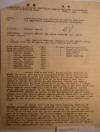
|
28 May 1932.
Contact Report,
Lt. E. T. Gray, Neptune Mine,
(contact at 1330, 21 May 1932), p. 1.
"Reference:
(Harlen Pefley) map, where contact took
place. (110.6-300.7) ¶
1. Upon learning accurate location of
one bandit group, I cleared with the
following patrol, at 1330, 21 May 1932.
¶ Sgt. Garcia, Agustine #2318,
Cabo Martinez, Carlos #1849, Raso
Alvarez, Gilberto #4948, Raso Chaves,
Rafael #4776, Raso Gomez, Leonardo
#3282, Raso Gorgena, Alejandro #3469,
Raso Lopez, Calixto #4893, Raso Mairena,
Inocente #4892, Raso Joshua, Erdenso
#4897, Raso Sanchez, Felix #4791, Raso
Sevilla, Eusebio #4895, Civico Domingo
Martinez, Civico Francisco Espinoza,
Civico Ramon Cruz, Civico Ramon Barohona
¶ Patrol took a due south
direction, our destination about six
miles from Neptune Mine. After
about forty five minutes traveling I
asked my guide how much farther the
group reported was from our present
position. He told me we were
almost half way. I turned to
motion the patrol on, and glancing
through the woods, I saw five men pass
and look directly at me. For the
minute I thought they were Civicos of
Lieut. Cursey’s patrol, who we had been
expecting. These bandits were
traveling over a new cut trail, about
fifteen yards from and parallel to our
own, going in direction of Neptune.
I immediately flanked my patrol to try
and encounter entire group, before they
(the bandits) could scatter.
Patrol moved fast in order to catch
them, and on entering their trail I
found it turned to sharp right angles to
our original one, along a steep and
thickly wooded hillside. ¶
2. We opened fire with BAR after
learning location of bandits automatic
weapon and gathered patrol back into the
trail. The flank movement was
miscalculated. We could not see
any bandits during first of the fire and
patrol ceased firing. Immediately
bandits gave us a heavy fire, then the
firing became irregular. I made an
aggressive advance toward the group but
to have continued would of placed patrol
in a deep ravine with the bandits about
ten yards above us on the opposite side.
Patrol moved around to the right, for an
offensive position and this action
routed the bandits. The bandits
used rifles, TEMG, shotguns and bombs. .
. . "
|
|
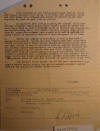
|
28 May 1932.
Contact Report,
Lt. E. T. Gray, Neptune Mine,
(contact at 1330, 21 May 1932), p. 2.
" . . . 3. From
evidence in the trail, reports, and
bandits firing position, I estimate this
group to be about 100 men, under Irias
and well armed with weapons and plenty
of ammunition, as they expended as much
or more than my patrol. ¶ 4.
We captured four riding animals, two
blanket rolls containing personal
clothing, and fifty round Krag, new
combat ammunition. Picked up over
a hundred round of various cal.
ammunition, springfield, krag, forty
five ammunition, and shotgun shells,
which were all spent. The animals were
equipped with native saddles. The
usual supply of machetes were also
captured. About 20 of them.
¶ 5. Patrol was unable to
ascertain or verify any bandit
causalities, however indications and
reports are that there were several
killed and a large number wounded.
My opinion, there were not many killed
if any at all. There were no
Guardia casualties. The contact
lasted approximately one hour. My
patrol expended 400 rounds Springfield,
900 rounds Krag and fifty shotgun
shells. We were armed with 11
rifles, Krag, 1 B.A.R., 2 Springfield
rifles, 1 grenade discharger with 6
grenades, (unable to use grenades due to
heavy brush) and three shotguns.
This contact took place at about 1430.
Cleared scene at 1550 and returned to
Neptune Mine about 1635. ¶
6. The conduct of my patrol was of the
most commendable and praiseworthy manner
during the entire contact. Sergeant
Garcia handled the B.A.R. with utmost
effectiveness. ¶ E. T.
GRAY."
|
|
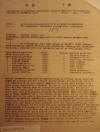
|
28 May 1932.
Contact Report,
Lt. E. T. Gray, Neptune Mine,
(contact at 0840, 23 May 1932), p. 1.
"Reference:
(Harlen Pefley ) map, (110.8-300.7)
where contact took place. ¶ 1.
On information that main group of
bandits under Pedron were traveling
toward Biltigni and apparently leaving
our immediate vicinity, I cleared with
the following patrol at 0840, 23 May
1932. ¶ Sgt. Garcia,
Augustino #2318, Cabo Vargas, Eliseo
#2130, Raso Agurcia, Rosendo #4644, Raso
Alvila, Domingo #4458, Raso Chaves,
Rafael #4776, Raso Cuarezma, Emilo
#4772, Raso Fernandez, Narciso #4745,
Raso Sanchez, Felix #4791, Raso
Villabolo, Ricardo #4808, Raso Lopez,
Calixto #4693, Civico Domingo Martinez,
Civico Dolores Castro, Civico Eustaquio
Silez, Civico Francisco Espinoza, Civico
Juan Duarte, Civico Juan Lopez, Civico
Julio Cruz, Civico Ramon Barahona,
Civico Francisco Gutierrez ¶
2. Patrol proceeded due west of Neptune
Mine on a trail which would not place us
between the two largest groups, which
were reported north of the station and
in this manner assumed we might gain
contact with both groups separately.
I cleared the patrol to a given place,
through the bush and formed them as
secret as possible, as all our actions
were being spied upon from the nearby
hills. This was a distance of
about one mile from Neptune Mine.
Patrol proceeded down the trail. There
was a large ravine, with a low wooden
bridge which six of us had crossed.
Three men in the point, Sgt. Garcia with
the (BAR), myself and the rifle Grenade
man. Bandits immediately opened
fire on patrol completely surrounding
us. My guide was struck down by a
machete and fired upon. The point
then had hand to hand conflict with the
bandits. Heavy BAR fire cleared a
position to our left and Sgt. Garcia
took charge of that point. I
re-crossed the bridge to get to the main
body, as they were receiving heavy
automatic fire from the bandits.
Crossing the bridge, I was stunned by a
bomb explosion for a minute and got up
to the main body placing Cabo Vargas in
charge of the left flank and Sgt. Garcia
on my right flank. We then gave
all of our attention to the bandit
automatic fire on the higher ground,
ignoring the single fire action in our
rear. I placed rifle grenades in
the most effective positions and patrol
gained the . . . "
|
|

|
28 May 1932.
Contact Report,
Lt. E. T. Gray, Neptune Mine,
(contact at 0840, 23 May 1932), p. 2.
". . . the
effective position, in a short time this
action routed the bandits. ¶
3. This group was reported to be three
hundred, and all evidence shows there
were a least two hundred well armed with
2 BAR’s, 1 TSMG, 2 Lewis MG, Krag and
Springfield rifles, shoguns, pistols,
bombs etc. Bandits used some sort of
bomb or grenade, which was discharged by
rifle, it does not have the detonation
or effect of a rifle grenade, however.
Bandit group was again under Irias,
instead of Pedron as earlier reported.
It seems Irias acted both on Pedron’s
rear guard and avanzaria, during entire
bandit activities this week. A
bugle was blown through the contact and
bandit jefe called out: Now I have
you Macho, you and all of your dogs.
This lasted about one hour and a half of
almost continuous fire and the bandits
must have expended as much or more
ammunition than my patrol. At the
same time of my contact, the power plant
at Big Falls was being attacked and on
my arrival in Neptune, the two
fortifications on hills overlooking the
town were also being attacked. The
airplanes timely arrival was a decisive
end to bandit contemplation and plans.
I laid Help panel in order to get more
forces to defend the Mine properly and
continue offensive action. The men
were all exhausted here. ¶
4. Patrol captured the following. 2
riding animals and saddles, 5 blanket
rolls containing personal clothing,
correspondence, 6 large cans salt, other
articles of food, twenty rounds Krag and
Springfield and picked up a great
quantity of spent Krag and Springfield,
45 cal., and shotgun shells. ¶
5. Bandit casualties known, 17 dead and
a number wounded. No serious
Guardia casualties. Bandit Jefes
were Pedron Altamirano, Pedro Irias,
Peralta, Sanchez Salinas, Simon Pineda,
Tomas Pineda, Hernandez, Centeno, Simon
Gonzalez and a brother of Pedron was
known to be with this group. ¶
6. My patrol was armed with 14 Krag
rifles, 2 Springfield rifles, 1 B.A.R.,
4 shotguns, six rifle grenades and
discharger. The contact took place
at about 0900 23 May. I cleared
for and arrived Neptune Mine 1116 23 May
1932. ¶ 7. The conduct of
the patrol was most commendable, and I
recommend that Sgt. Agustino Garcia
#2318 and Cabo Eliseo Vargas #2130 be
especially commended for their
praiseworthy performance. The
Civico group all voluntarily
participated in the contact, in the most
excellent manner. ¶ E.T.
GRAY."
|
|
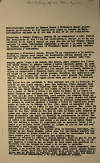
|
30 May 1932.
Declarations of
Damaso Gómez & Florencio Sáenz,
District of Neptune Mine, to Commanding
Officer GN, p. 1.
[NOTE:
This important document is presented in
three ways and analyzed in
TOP 100 PAGE 85:
(1) as an exact transcription, (2) in
standard Spanish, and (3) in English
translation. Here it is presented
in standard Spanish.]
"Declaraciones
tomadas de Damaso Gómez y Florencio
Sáenz quienes fueron prisoneros de los
bandoleros desde el veinte de Mayo
[1932], habiéndoles soltado en el río
Asa el día 29 de los corrientes. ¶
Preguntas a Damaso Gómez . . . ¿Pórque
Ud no compareció a esta cuando fue
notificado el día 19 de los corrientes?
Porque yo no me encontraba en mi casa y
cuando yo supe era que ya las tropas
tenían rodeada la casa, habiéndome
capturado y traído a la casa de Daniel
Reyes y después a la casa de Florencio
Sáenz a quienes también aprendieron y
amarraron. ¶ ¿Cuánta gente
llegó donde estaba el propio Pedrón y
había bastante gente? Él estaba en
la bodega vieja de Aguas Calientes y ahí
durmieron. El siguiente día
estaban para matar una res cuando los
aviones, entonces ellos se espantaron y
tomaron rumbo hacia el tesoro o sea el
camino viejo de la Panamá al Salto
Grande. Nosotros aun estábamos
amarrados. A la bajada del tesoro
o sea un cerro grande fue cuando fue el
fuego y todos se esparcieron unos por un
lado y otros por otro. ¶
¿Con quién era que peleaban? Pues
supongo que son la Guardia, nosotros no
nos dimos cuenta, pero fue nutrido.
(This amongst themselves, as there was
no fighting that day with the Guardias.)
Después de eso fuego Pedrón se fue rumbo
al Salto y dijo que él se iba a tomar El
Salto y Irías y su gente la Mina.
En la finca de Pedro Vásquez nos
tuvieron por dos días y ellos salían con
su gente como que ya iban adentrara,
pero cuando les rompían fuego de las
fortalezas retrocedían.
Seguramente se dieron cuenta del Salto
de donde se encontraban parte pusieron
la máquina propiamente donde estaba el
cuartel general y Pedrón y todos se
espantaron yendo rumbo al lado de la
Bodega de Pis Pis, donde se encuentro
con el General Irías y ya lo contó lo
que los había pasado. Esa noche
dormimos en esta finca y al siguiente
día salimos rumbo hacia la Bodega de Pis
Pis. Irías se fue por el lado de
Casca pero después supimos que venía
atrás de nosotros porque él mandó un
correo a Pedrón diciéndole que venía la
Guardia en persecución de ellos.
Cuando nosotros estábamos donde [Juarez]
oímos los tiros atrás y Pedro se metió a
la montaña y dió orden a su gente que si
había fuego que nos matara a todos.
Al siguiente día se apreció Irías y su
gente y ya salimos todos juntos.
Al llegar al río de Asa ahí nos soltaron
y nos venimos por montaña. ¶
Quienes eran los jefes, con Pedrón iban
un Sánchez, Santiago, Peralta y un tal
Tomás Piñeda, estos eran los que hicimos
montar. Con Irías andaban un Simón
González y los demás no recordamos los
nombres porque poco les vinos pues nos
andaba Pedrón. ¶ ¿Porque le
volaron la cabeza a Daniel Reyes?
Pues es que él iba con nosotros y como
en el fuego mataron el custodia de él,
él logró fugarse y resulta que en lugar
de irse donde los guardias se encuentro
con las tropas de Irías y si no más lo
mataron. ¶ ¿Andan bien
armados y vestidas? Que va señor,
andan haraposos, descalzos, y es cierto
que andan máquinas, pues cuatro andaba
Pedrón y cuatro Irías, pero creo que
andaban poco parque. La esperanza
de ellos era de entrar al Neptune, para
acabar con todos los Machistas
piñedistas moncadista, y en fin
improperios decían. . . . "
|
|
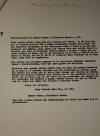
|
30 May 1932.
Declarations of
Damaso Gómez & Florencio Sáenz,
District of Neptune Mine, to Commanding
Officer GN, p. 2.
" . . . ¿Como
cuánta gente creen Uds que andaban por
todos? De las tropas de Pedrón
andaban 250 y según nos dijeron andaba
otro tanto Irías. Nosotros
solamente en dos ocasiones vimos a Irías
y es más sanguinario que Pedrón, pues
según sus frases está más ardido desde
la derrota que tuvo en Biltigni.
Pedrón mandó a avisar a Irías que ya
podía atacar la Mina, que él se
encargará de la Mina y Pedrón se tomaría
El Salto, que de El Salto lo llamaría
para reunirse en El Neptuno. Pero
todo se engañaron. ¶ ¿Que
decían los soldados después de la
derrota? Estaban desconsolados y
aterrorizados. Creo que esas
gentes no volverán. ¶
Nosotros hemos pasado cuatro sustos pues
de nada nos ponían machetes en la nuca y
lo sobaban diciendo que nos cortarían la
cabeza, pasa que Pedrón dió orden que si
había otro ataque nos volarán la cabeza.
Cuando nos dieron libertad dijo Pedrón
que él que quisiera ir con su gusto que
se fuera con él. De todos los que
andábamos que eramos once, solamente dos
Teodoro y Miguel Romero fueron los que
se fueron con él. Todos los demás
nos venimos a nuestras casas. ¶
Copia del original. ¶ Mina
Bonanza Mayo 30 de 1932. ¶
Damaso Gómez y Florencio Sáenz. ¶
Poco más o menos fueron las
declaraciones de todos los demás que se
presentaron."
|
|
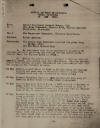
|
1.
31 May 1932.
Combat Mission,
2nd Lt. Leonard Curcey, Wuani, p.
1.
"References: (a)
Orders Area Commander received via plane
drop, 23 May, 1932. (b) 5th Regt.
Special Map. ¶ 1. In
compliance with above reference I am
patrol of nineteen enlisted guardias,
six civicos and one native guide cleared
Wauni for Neptune Mines at 07424.
¶ 2. Orders for patrol were to
proceed to Neptune with all possible
speed, join forces with that Detachment,
organize defense, patrol area working on
local information and gain contact with
bandit groups in the vicinity of mine.
¶ 24 May Patrol cleared Wauni at
0740 on Pis Pis trail for Neptune
arrived and made camp on Fernandez Corro
at 1710. Very evident trail had
been travelled by large group. ¶
25 May Cleared Fernandez Corro at 0530
arrived and made camp at Lauriano Mateos
house at 1630, house unoccupied. ¶
26 May Cleared Lauriano Mateos House at
0600 arrived at Neptune at 1330.
Trail from this point to Neptune showed
no sign of Bandits having travelled over
it. Rain responsible.
Devoted rest of day to cleaning
equipment and arms. ¶ 27 May
Cleared Neptune at 0800 and on
information obtained from natives
proceeded toward the Bodega from Bonanza
Mine on Limon trail and about 3 miles
from the Bonanza picked up a newly cut
trail over two hills due East to the
lone star range continued along the lone
star trail, see attached sketch.
Trail along lone star not shown.
Myself and patrol followed trail and it
was very evident Bandits were ahead of
us by the signs of pools and chewed
sugar cane strewn along trail. We
continued along this trail for a period
of about four hours and come on to the
Limon trail just on the outskirts of the
town and noticed that they were still
ahead of us we pushed right along for a
. . . "
|
|
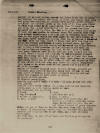
|
2.
31 May 1932.
Combat Mission,
2nd Lt. Leonard Curcey, Wuani, p.
2.
" . . .
period of an hour having passed the
first house out of Limon and nearing the
second one which is about one league
away when our point was climbing an
incline when patrol, point rather, got
about one hundred yards up the side to
it they were fired on from both sides by
a heavy rifle fire followed by machine
gun fire. The point immediately
hit the ground for cover extended and
took up fire. The BAR with point
swept both sides of bush but was unable
to silence them. The guardia main
body upon attack immediately took
position in extended order thru bush to
the right while the rear guard to the
left taking up the fire. After
carefully looking over the situation I
directed the BAR with our rear guard to
sweep bush with his fire but still the
firing continued. I again noticed
where the fire from the machine gun was
coming and directed the Rifle Grenade
man to drop a few grenades in that
direction and with our automatic weapon
sweeping the bush we were able to drive
them away. Bandits were driven
thru the bush toward the top of hill
where a house was located. We now
proceeded forward very cautiously until
we reached house and noticed that
Bandits were unable to take anything
with them (such as articles captured).
Trail was on other side of hill and
direction Wuani. It was rather late and
made camp there for night.
Engagement took place at or about 4:40
PM and lasted for a period of 20 to 25
minutes. ¶ Number of bandits
engaged about 50 with Rifles, pistols
and shotguns. Also several dynamite
bombs were thrown. It was rear
guard of Pedron group which attached
Neptune and was under the command of
Jefe known as Irias. ¶ No
known bandits killed. ¶ No
Guardia casualties. ¶
Guardia employed 2 BAR’s – 1 STMG – 21
Krag Rifles and 1-45 Cal. pistol.
¶ Bandits about 40-50 rifles.
Shotguns, pistols and dynamite bombs.
Also an auto weapon, Lewis or BAR.
¶ The following was captured.
¶ 3 mules, 1 hog (dressed), 5
sticks of Dynamite, 15 Lbs. of Lard, 3
cows, 8 Blankets wet old, 10 Lbs. of
salt, 2 Cutachas with scabbards, Old
Clothing, cooking utensils, medicine,
dried corn on cob, one sak and three
bunches of green bananas. ¶
Mules are now at Wuani in Guardia
Potrero. Cows left on trail at
scene of engagement, owners will be
notified thru Neptune Guardia and be
permitted to get same. All other
articles destroyed. ¶ The
following is list of officers and
Guardia participated in contact:- . . .
"
|
|
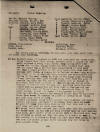
|
3.
31 May 1932.
Combat Mission,
2nd Lt. Leonard Curcey, Wuani, p.
3.
" . . . 2nd Lt.
Leonard Curcey, Sergeant CHAVEZ, Alberto
#58, Corporal PINNOCK, Levy #4821,
Corporal MORALES, Alfredo #141, Raso
FLETES, Justino #3362, Raso CARDOZA,
Jesus #3424, Raso CASTELLON, Simeon
#3241, Raso VELASQUEZ, Luis #4630, Raso
GUTIEREZ, Adolfo #4747, Raso BROCK,
Cecil #2996, Raso MATUTE, Santiago
#4749, Raso MARTINEZ, Salomon #3556,
Raso FLORES, Encarnacion #4756, Raso
DUARTE, Ceferino #4750, Raso RUGAMA,
Julian #4899, Raso RENOS, Sipriano
#3227, Raso LYNCH, Willie #4732, Raso
VILLALOBOS, Ricardo #4808, Raso AVILLA,
Domingo #4458, CABO VARGAS, Eliseo #2130
¶ CIVICOS. ¶ BOGRAN,
Tranquilino, CRUZ, Pablo, FLOREZ, Pedro,
RODRIGUEZ, Juan, CENTENO, Felix,
PADILLA, Rafael. ¶ The entire
patrol including Civicos were very cool
under fire and acted like veterans.
¶ 28 May Cleared scene of contact
at 0530 and continued our chase along
trail toward Wuani after having covered
about a league and one half, noticed a
newly built Bandit camp uncompleted with
leaves for roofing laying aside and very
evident that camp was not slept in.
A cow had been slaughtered at this camp
but only a small portion of the meat
taken with them rest of carcass left
there. A league or so further
another camp similar was found to be
uncompleted with another cow slaughtered
and little of the meat taken. In both of
the camps many articles of wet clothing
were left behind along with them two
pair of guardia leggings and two rubber
ponchos such as issued to guardias, they
were no means of identification though
have reason to believe that the Kisalaya
guardias deserters had joined Pedron.
Ammunition and Arms used at Neptune and
our contact were some of those taken by
deserters. Some of the empty
shells, picked at scene of engagement in
bandit position were Krag combat and
casings almost new. We continued
chase from scene of contact to place on
outskirts of Suina and made camp there
at 1940. ¶ Noticed all along
trail where bandits were shedding old
shoes, leather leggings, articles of
clothing. There were at least 30
pair of shoes which were worn so bad
that they had to be cast away and hike
in their bare feet. ¶ All
along trail also noticed that their main
diet was sugar cane and dried corn on
the cob and very evident knew we were
pushing them hard. Lost Bandit trail at
about 1800 at Eldorado when they all
trailed up creek and thru the bush to a
trail to Asa. I was anxious to
continue to Suina for fear they were
going to enter town and murder people
there because they had taken up Arms
again them. . . . "
|
|
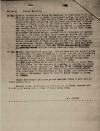
|
4.
31 May 1932.
Combat Mission,
2nd Lt. Leonard Curcey, Wuani, p.
4.
" . . . 29
May Cleared outskirts of Suina at
daybreak to find Suina very quiet.
When we entered it at 0550, I purchased
coffee for patrol and cleared for Wuani
at 0730 reaching Wuani at 1000.
Upon my arrival dispatched Lieut.
Palacios, ten enlisted guardias and
thirteen civicos of fresh troops to Alo
with a view of cutting Pedron and his
group off thinking he might be forced to
return that way because there are no
cattle or bananas toward Casa Vieja, the
only other route out of this Area.
¶ Lieutenant Palacio’s Patrol
covered trail travelled by bandits from
Alo to a point on Wani River known as
Laimus but did not make contact nor
could he obtain any information of
bandit whereabouts because all natives
on the upper river here either stayed
here at Wuani or gone to the bush until
Bandits clear District. Lieut. Palacio
cleared Wuani at 1100 May 29-32 and
returned to Wuani at 0930 May 31-32
without having seen anything of Bandits.
¶ 30 May Myself, ten enlisted
guardias, ten civicos and one native
guide cleared Wuani for Asa at 0730 on a
combat mission on information that a
group of Bandits had been seen there.
Arrived at Asa at 1230. No bandits
nor any sign of trails as having been
travelled by any group. Returned
Wuani at 1730. ¶ At 0830
sent native scout with two days rations
on upper Wuani and Uli River for the
purpose of locating or picking up traces
of Bandits. Scout returned at 1630
May 31-32 with information that Bandits
were cutting new trail from point
(19.7)-(E-7) over mountains to
headquarters of Rio Illas, not shown on
map, or else to Matagalpa trail to town
of Illas thence to Bocay or Cubuli.
¶ Since Lieutenant Palacio’s
patrol arrived today I have had no other
patrol out. ¶ In any event,
I obtain any information of their
whereabouts I will give chase with a
view of destroying them. ¶
L. CURCEY"
|
|
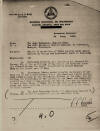
|
5.
31 May 1932.
Combat Mission,
2nd Lt. Leonard Curcey, Wuani, p.
5.
" . . . 1.
Forwarded herewith is a report by Lt.
Leonard M. Curcey, GN, of the activities
of the troops and Civicos under his
command during the bandit concentration
around Neptune mine in the latter part
of May. ¶ 2. Lieutenant
Curcey acted promptly on receipt of
orders and by his aggressiveness, sound
judgment and active patrolling aided
greatly in the successful defense of the
mine, and enforcing the withdrawal of
the bandits to the West. His energetic
pursuit kept them moving rapidly and
denied them any opportunity to raid
either Siuna or Wauni and forced them to
abandon livestock and other articles of
supplies and equipment in the haste of
their retreat. ¶ 3. The Area
Commander feels that Lieutenant Leonard
E. Curcey, GN. should be commended for
his excellent work. ¶ L. L.
LEECH"
|
|
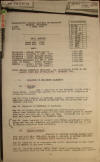
|
1 June 1932.
Extracts from
GN-2 Report Covering the Month of
May 1932. [NOTE:
These excerpts constitute the
sum total of text devoted to the
Atlantic Coast region in this 32-page
intelligence report covering the entire
country, except two reports by Eastern
Area Commander Col. Leech on May 27,
which are included in chronological
sequence in these East Coast pages.
The image to the left is the report's
cover page only.]
"
[p. 1]
LOCATION OF THE
ENEMY ELEMENTS. ¶ . .
.
[p. 4]
PEDRON ALTAMIRANO:
Reported with 200 bandit at Los Terreros
on May 14. On May 16 reported
group split into two equal parts and
proceeded toward Coco River. ¶
. . . May 21: Reported in contact with
Lieutenant Gray and patrol from Neptune
Mine, near the mine. ¶ May
22: Reported with group of 500 in
vicinity of Neptune Mine, planning an
attack in force upon that place. ¶
May 23: Reported in contact with
Lieutenant Gray and patrol one mile west
of Neptune Mine. [NOTE:
Of the 16 jefes surveyed in this
section, only Pedrón was reported active
in the Eastern Area.] ¶
. . .
[p. 6]
UNITS IN CONTACT.
¶ . . .
[p. 7]
May 23 – Lieutenant Gray and combined
guardia and civico patrol of 20 men had
contact lasting thirty minutes one mile
west of Neptune Mine on May 23rd with
large bandit group under Pedron
Altamirano which has been threatening
guardia post at that place.
Fighting very tense. Upon return
of patrol to Neptune Mine, cuartel was
attacked by another group from north but
attack repulsed. Planes by bombing
dispersed bandits and broke up further
attack. Bandit casualties 17
killed. No serious guardia
casualties. [NOTE:
Of the 16 contacts reported in May, only
the foregoing contact at Neptune Mine
was in the Eastern Area.] ¶
. . .
[p. 8]
STRENGTH AND
MOVEMENT. [NOTE:
Of the 41 items in this
category, none concerned the Eastern
Area.] ¶ . . .
[p.
13]
WEEKLY SUMMARY OF
INTELLIGENCE, WEEK ENDING 2 MAY 1932.
¶ . . .
GENERAL INFORMATION. ¶ . .
. The recent report of bandits operating
west of Rama near the Chontales border,
has been found to be much exaggerated.
A small group of local thieves have been
causing trouble and have been spreading
the report that a large bandit group was
in that section. ¶ . . .
[p.
15]
WEEKLY SUMMARY OF
INTELLIGENCE, WEEK ENDING 9 MAY 1932.
[NOTE:
Nothing on Eastern Area.]
¶ . . .
[p.
17] WEEKLY
SUMMARY OF INTELLIGENCE, WEEK ENDING 16
MAY 1932. [NOTE:
Nothing on Eastern Area.]
[p. 18]
¶ . . .
WEEKLY SUMMARY OF INTELLIGENCE, WEEK
ENDING 23 MAY 1932. ¶
. . . Neptune Mines reported engaged
with large group estimated as 500, one
of the jefes said to be Pedron
Altamirano, 22 May. ¶ . . .
ESTIMATE.
¶ The movement of bandit groups
during the week indicates a drift from
the north into the Departments of Leon
and Chinandega, and a renewal of bandit
activity on the Atlantic Coast,
particularly in the mines region.
An exceptionally large bandit
concentration has been made around the
Neptune Mines. However, the
initial attack of the bandits was
repulsed with the assistance of planes
from Puerto Cabezas and the situation is
improving in that section. The
bandits have never sustained
[p. 19]
any given attack longer than a few hours
and in this case they will probably
remain in the vicinity of the mines
watching for an opportunity to make
another attack. The arrival of
reinforcements at Neptune will clear the
bandits out of that immediate section.
If the number of bandits is as great as
estimated at Neptune, they will in all
probability break up into lesser groups
and cause much trouble in the lower Rio
Grande section and in Northern
Bluefields for the next two weeks. . . .
¶ [p.
20]
WEEKLY SUMMARY OF
INTELLIGENCE, WEEK ENDING 30 MAY 1932.
¶ BANDIT
GROUPS. ¶ Large
bandit group under Pedron Altamirano
engaged by Lieut Gray and guardia patrol
from Neptune Mines about one mile west
of mines. Bandit casualties 17
killed. No guardia casualties.
Another bandit group attacked Neptune
same day but were dispersed by return of
Lieut Gray and a bombing attack by
planes from Puerto Cabezas. ¶
. . . GENERAL
INFORMATION. ¶ . . .
[p.
21] Reports from
the Atlantic Coast are to the effect
that the vigorous operations of the
Neptune Mine Detachment supported by
planes from Puerto Cabezas, broke up the
bandit concentration in the mining
section. The bandits have
dispersed and no reports have been
received as to where they went.
Some bandits are reported in the Dept.
of Northern Bluefields but they are very
short on ammunition and are avoiding
contact with the Guardia. ¶
. . .
[p. 32]
CONSOLIDATED
REPORT OF CONTACTS OF THE GUARDIA
NACIONAL FOR THE MONTH OF MAY 1932.
¶ . . . NEPTUNE MINE, 21st, Lt.
Grey, 4 animals, saddles captured.
¶ NEPTUNE MINE 23rd, Lt. Grey, 17
bandits killed. . . . [NOTE:
Of the 15 contacts reported for the
month of May, only these two were in the
Eastern Area.]"
|
|
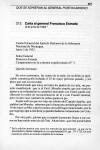
|
1.
3 June 1932.
Carta, Gen.
Augusto C. Sandino to Gen.
Francisco Estrada, p. 1. (Source:
A. C. Sandino, El pensamiento
vivo, v. 2, pp. 227)
|
|
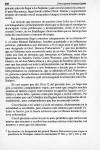
|
2.
3 June 1932.
Carta, Gen.
Augusto C. Sandino to Gen.
Francisco Estrada, p. 2. (Source:
A. C. Sandino, El pensamiento
vivo, v. 2, pp. 228)
|
|
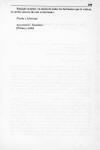
|
3.
3 June 1932.
Carta, Gen.
Augusto C. Sandino to Gen.
Francisco Estrada, p. 3. (Source:
A. C. Sandino, El pensamiento
vivo, v. 2, pp. 229)
|
|
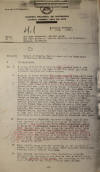
|
1.
7 June 1932.
Record of Events, Eastern Area & Dept of
Southern Bluefields,
Col. L. L. Leech,
Bluefields, p. 1.
"Record of
Events, Eastern Area and the Department
of Southern Bluefields. ¶ E
INTELLIGENCE. ¶ May 2 A
group of forty-give bandits JUAN MORALES
(Jefe), was reported moving up the ULAN
RIVER from SANDY BAY. Five automatic
weapons and twelve rifles. ¶
May 8 A group of forty bandits POLICARPO
FONSECA (Sub-Jefe) raided PASO LAJAS
near CHONTALES border. Two Guardia
deserters were reported to be with this
group. FONSECA, a former resident
of MUELLE DE LOS BUEYES, was dressed in
full Guardia uniform, was armed with a
pistol and Springfield rifle. His
description was given as stocky build,
complexion, yellow. The group was
armed with the Springfield, some KRAG
rifles and shotguns. This group
operated in the vicinity of the UPPER
SEQUIA to the extent that many families
have moved from that district into RAMA.
Included against those were two Jueces
de Mestas. Do not believe this
group to be well armed due to the fact
that they have avoided contact with
Guardia patrols and that they failed to
make any attempt to raid MUELLE REAL and
EL RECREO. (A patrol from RAMA
followed the above mentioned group into
CHONTALES without result). The
better class of people are leaving the
UPPER SEQUIA fearing trouble. It
has been reported to the Guardia at RAMA
that the Conservative element is
prepared for any emergency should a
Liberal candidate be reelected this
year. ¶ May 12 Reliable
native (SALGADO) reported at WUANI that
he had been captured the day before by a
group of bandits two hundred to two
hundred and fifty. PEDRO
ALTAMIRANO (Jefe), in vicinity of
MATAGALPA TRAIL at point (19.5-EE 05)
5th Regt. Special Map. At this
place the bandits point, with whom
SALGADO was, made camp. ALTAMIRANO with
the main body and rear guard continued
crossing the trail and were cutting
their way through in a northerly
direction with a large number of machete
men. This group was apparently out
of food, poorly clothed and not well
armed according to SALGADO’S report.
¶ May 13 Small bandit group
reported operating in the vicinity of
MUELLE DE LOS BUEYES on RIO MICO.
(Jefe unknown) Destination unknown.
Patrol cleared from RAMA. ¶
May 14 CAPE GRACIAS reported that from
information received through a spy
captured by the Guardia that a bandit
group of fifty, ABRAHAM RIVERA (Jefe),
was operating in the vicinity of CRUTA
and was moving towards CAPE GRACIAS. . .
."
|
|
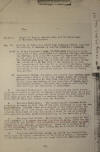
|
2.
7 June 1932.
Record of Events, Eastern Area & Dept of
Southern Bluefields,
Col. L. L. Leech,
Bluefields, p. 2.
" . . . May 16 A
group of fifty well-armed JUAN GONZALES
(Jefe), reported in vicinity of SACKLIN
by Guardia Commander, KISALAYA. ¶
May 19-26 On 19 May Lieutenant
GRAY, NEPTUNE MINE reported a group
estimated at 300, ALTAMIRANO and
GONZALES (Jefes) surrounding NEPTUNE.
This group was apparently augmented by
other groups until it numbered not less
than 500 (estimated). The NEPTUNE
MINE Area was so infested with bandits
during the period 19 to 26 May that it
was necessary to stop all operations at
the Mine for a period of six days.
Normal activities at the mine were
resumed the 27th. Planes aided
materially in the operations against the
bandits during this period. ¶
May 27 Lieutenant CURCEY, following the
bandits from NEPTUNE MINE made contact
with a group near JUANON, IRIAS AND
PERALTA (Jefes) information at this time
indicated that the main bandit group was
heading in the direction of WUANI.
Later information however, indicates
that bandits were heading west and into
the department of MATAGALPA. ¶
2. Military Situation:- Do not
anticipate any large concentrations of
bandit groups in the Eastern Area during
June. It is possible that several
small groups are still within the area
limits and that these groups will harass
the smaller farms in the outlying
districts avoiding all contact with the
Guardia. ¶ 3. Economic
Situation:- The banana export
business which invariably slackens at
this time of the year continues to hold
its own. Approximately 100,000
stems were shipped to the states during
the month of May. At no time
during the past two years has the banana
industry flourished as now. The
price of fruit is low as compared with
previous prices. Conditions
generally on the coast are good. ¶
4. Sanitary Conditions:- Satisfactory.
As a result of the establishment of a
womans venereal hospital in April, under
the supervision of the Guardia, the
percentage of venereal cases in
BLUEFIELDS has been reduced
considerably. There was a decided
drop in the percentage of fever cases
during May as a result of daily showers
during the month. ¶ 5.
Political Situation:- Quiet.
On the 2nd the Conservative party held
its annual convention at the Variety
Theatre. Delegates to the National
Convention and the local directive were
selected. . . . "
|
|
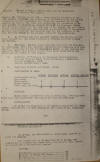
|
3.
7 June 1932.
Record of Events, Eastern Area & Dept of
Southern Bluefields,
Col. L. L. Leech,
Bluefields, p. 3.
" . . . Meeting
was orderly. On the 5th. a local
campaign favorable to Dr. ENOC AGUADO,
incumbent Vice President of the Republic
for the Liberal nomination for the
presidency was officially launched.
On the 8th meeting was held in the local
park sponsoring the nomination of Dr.
ENOC AGUADO, for presidency.
Alcade SPRINGER and Treasurer IBARRA are
the Chief booters for the candidacy of
Dr. AGUADO. The politically minded
are following with real interest the
proceedings of the Liberal National
Convention and the majority hope for the
reelection of Dr. Juan Bautista SACASA
as the Liberal nominee for the
presidency. ¶ 6. No friction
has been reported between the Guardia
and the civil population. The press
continues a friendly attitude towards
the Guardia. ¶ 7. Weather:-
Weather conditions have been good and
favorable for patrolling. River and
coastwise transportation schedules have
been regular. Visibility for air
reconnaissance except on the occasion
has been good. There were showers
and at times heavy rains during the
entire period covered by this report.
¶ 8. Condition of Telephone and
Telegraph Communications:- ¶
Civilian Tropical Radio Telegraph
Company – Excellent. ¶
Guardia KISALAYA – NONE. ¶
Guardia NEPTUNE MINE – GOOD. ¶
F CONFISCATION OF ARMS. ¶
Confiscated during the month Serviceable
– 2 RIFLES, 2 PISTOLS ¶
Confiscated during the month
Unserviceable – 4 PISTOLS ¶
Previously reported – 6 RIFLES, 6
SHOTGUNS, 11 PISTOLS ¶ Total
– 8 RIFLES, 6 SHOTGUNS, 11 PISTOLS, 0
CUTTING WEAPONS ¶ G TRAINING
¶ Except where interfered with by
patrolling, training schedules have been
maintained. Discipline has been
satisfactory. ¶ H
MISCELLANEOUS ¶ On 13 May
the President of the Republic appointed
Sr. THOMAS OCAMPO, Jefe Politico of CAPE
GRACIAS as the relief of Sr. FRANCISCO
GARCIA. ¶ On 13 May, the
Jefe Politico, BLUEFIELDS, cleared by
plane for MANAGUA. ¶ The
fiesta held in EL RAMA from 28 to 30
May, was orderly and no arrests were
made during this period. This
fiesta was authorized by Presidential
Decree. ¶ I CIVICOS:-
¶ Bluefields 74, District of
Siquia (El Rama) 15, El Gallo 10, Rio
Grande Bar 12, Neptune Mine 95."
|
|
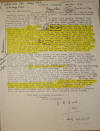
|
8 June 1932.
Letter from G. R.
Heath, Kaukira, Honduras, to A.
O. Danneberger.
"Dear Br.
Danneberger, ¶ Enclosed I am
sending you a report of a recent
evangelistic journey to Brus and other
places. I hope the Provincial Board will
give it careful consideration. ¶
On the Butuk River (Patuca) and in Brus
I met various refugees from the Sangsang
region. You have, I believe,
visited Sangsang, and will remember many
of the people. I fear that their
present condition is not fully
understood. Apart from those who
have fled down the river there seem to
be three groups. One group has
made common cause with lawlessness and
violence. Another set of men are
trying hard to have nothing to do with
wickedness, but do not leave the
district partly because they are afraid
that if they go they may lose their
lands, and partly because they have been
threatened with death if they have
anything to do with the Guardia.
They have suffered greatly and are often
in hiding. Such are Reuben Wilson
of San Carlos, Jesus of Asang, and with
them Petrona Spicer of Sangsang whose
husband – a bad character – is dead.
In between these two groups is another,
which does not wish to commit any crime,
but which cooperates with the insurgents
in the honest belief that they are the
real rulers of the land. They have
been told that the Lower Wangks and
Bilwi are the only parts that still hold
out: and that as soon as these are
captured the Indians who took refuge
there will be severely punished. ¶
How many have fled to the Butuk I do not
know; but I do not think there are many
who have built houses, cut boats,
planted, and in general prepared for a
long stay. From what I can hear
most are going backwards and forwards.
Not long ago, I am told, news came over
that there would be no more fighting and
that all should return. A number
went back, and were promptly captured
and forced to do service. ¶
There is one Jonas Dixon Reyes of
Kiplapini (Carrizal) who was formerly an
applicant for baptism, but was careless.
Some time ago he became very ill and
apparently died; but as the body
remained warm they did not buy him; and
eventually it turned out that he was
only in a trance. He now is
preaching to the people; and sent me a
letter (written by a friend’s hand), in
which he complains that the people now
have no shepherd, and adds that he is
doing his best to feed the scattered
flock. Whether this is a case of
real conversion, or only of “spirtism”
and self-exaltation, I have not enough
information to judge.
Unfortunately the Miskito language as
commonly used would quite allow of the
phrase “died and rose again” to be
applied to a deep trance, as he seems to
apply it. So I have taken care to
point out to all and sundry that our
Lord’s Resurrection, on which our faith
rests, is a very different matter
indeed. ¶ With best
brotherly greetings, ¶ I
remain, ¶ Yours faithfully,
. . . "
|
|
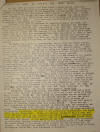
|
1.
8 June 1932.
Report by G. R.
Heath, Kaukira, Honduras, "A
Visit To Brus and Other Places," p. 1.
"A VISIT TO BRUS
AND OTHER PLACES. ¶ In July
1931 an Indian from Brus named Woodrow
Wilson, with his wife and stepdaughter
came to Kaurkira and applied for
baptism. Serious illness of
various members of his household, and
two deaths, prevented him from returning
for instruction before Easter. Since
that – indeed since January – the famine
has been severe throughout this while
region; they could bring very little
food, and we of Kaurkira had practically
nothing to offer them. More than
once Woodrow wrote, by the hand of a
neighbour, explaining his case. ¶
Although this part of Honduras is
considered quiet and safe, yet Kaurkira
is on the usual track of every kind of
traveler and wanderer, and the mission
premises are, unavoidably, very
isolated. During our first months
here, therefore, I hesitated to be away
from home more than a few days at a
time, but the passing of the months have
given more confidence; and as my wife
was remarkably free from all traces of
fear, I left for a fortnight’s journey
on May 18th. The Brethren Leo
Mueller and James Marley of Wahamlaya
came with me, and we had one Joseph
Bendless, a young heathen Indian from
here, as our pilot and our canoe-captain
for lagoons. ¶ The Caratasca
Lagoon is considerably larger than the
Pearl Lagoon, and is very treacherous.
Though we had no rough weather, the wind
was contrary, and at the end of the
first day we only reached Krata.
Here we had evening service.
Meetings at Krata are always well
attended and apparently appreciated; but
as yet the people will not trouble to
journey to any other village to hear the
gospel, even though invited. ¶
Leaving at daybreak, we still had more
than six hours on the lagoon.
(That is, the Caratasca Lagoon.) Just
inside the very much smaller Warunta
Lagoon there is high ground suitable for
camping; but after this NO MORE FOR
EIGHT HOURS’ PADDLE. Night caught
us just inside the Tilbalakan Creek.
We pulled our boat into a shallow reed
marsh, and erected our large tarpaulin
into a shelter from rain; but the
mosquitoes allowed us no sleep at all.
So at two in the morning we went on by
moonlight up the Ribra Creek.
Seven hours’ paddle against the current
brought us to the Butukauas landing.
From there the savanna path of four
miles or so to Butukauas is quite good,
with no bad creeks or sloughs to pass.
The path to Paptalaya (which I tried on
our return) is of about the same length,
but bad. That from Tilbalakan to
Krupunta is notorious. But there are
times when it will be better to wade the
Tilbalakan swamps rather than spend four
or five extra hours in the Ribra Creek.
We were impressed by the fact that it is
ONLY IN VERY EXCEPTIONAL CIRCUMSTANCES
THAT ONE CAN GET FROM KAURKIRA TO THE
BUTUK IN TWO DAYS. It usually takes most
of three days. ¶ BUTUKAUAS contains 20
houses; Paptalaya, about a mile and a
half to the north, 10 more; Krupunta,
about a mile and a half north of
Paptalaya, 5 more. Total 35. But Waksma
and Auasdakban can be reached in a few
hours across the savanna in ordinary
weather; so that the total number of
houses in the immediate neighbourhood
would be about 50. The attendance and
interest at our service was good; and we
left with a promise of spending Sunday
29th with these people. There are not
many mosquitoes at Butukauas, whereas at
Krupunta they are unusually bad. ¶
Twelve hours’ hard paddling brought us
to Brus late on Saturday night.
There are no settlements on the lower
river, as human habitation is rendered
impossible, not only by the periodical
inundations, but especially by the
mosquitoes. These are vicious
enough to kill a dog; and it is affirmed
that on one occasion the Indians tied a
certain criminal hand and foot and left
him for the night on a gravel beach.
One night was enough; in the morning he
was dead. Our camp experience on
our return journey convinced us of the
probable truth of this story. The
other branch of the Butuk, which reaches
the sea at Butuk Bar, is longer.
In ordinary dry weather it takes a full
day and a half to each Butukamaya (Butuk
Bar) from Butukauas or Krupunta. . . . "
|
|
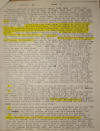
|
2.
8 June 1932.
Report by G. R.
Heath, Kaukira, Honduras, "A
Visit To Brus and Other Places," p. 2.
" . . . Thus in
ordinary circumstances it takes FOUR
DAYS to reach Brus from Kaurkira; and,
as will be seen, it takes FIVE DAYS TO
COME BACK. ¶ Before
nightfall on Saturday 21st we were
fortunate enough to overtake two of Leo
Mueller’s nephews paddling on the lower
river; these guided us to the house of
their father, James Gough, by which we
were most hospitably entertained.
In 1930 Br. Stortz and I stayed at the
main village of Brus; and next morning
as we journeyed across the lagoon we
were shown another group of houses, but
we did not meet the people from there,
who were said to be few. I now
find that this group is almost as large
as the main one. Along with the
usual type of Miskito Indian found in
these villages there are thirty or more
half-whites, children of American or
French fathers and Indian mothers, the
Esterbrooks, Woods, Goughs, and Youdes.
Many of them speak a certain amount of
English and Spanish, and one to two can
read well. Woodrow Wilson and his
wife, though Indians, belong to this
group, as Bella Wilson is the mother of
the Esterbook clan, their father having
died long ago. These people are
VERY ANXIOUS FOR GOSPEL PRIVILEGES; and
seem to be open and sincere, and to have
no by-ends about them. They feel
that their ignorance of spiritual things
is a shame to totem, and wish to be
taught. Of course we reminded
them: “Ye must be born again”.
“Yes”, said they, “that is just the sort
of thing we want to know about….. and
will you teach us to pray?” Again
we explained that, apart from the Lord’s
Prayer, which itself was not a
prescribed formula for every occasion,
the important matter was go give thanks
and offer petitions in sincerity, truth,
and submissiveness. “But,” said
Mr. Gough, “could you not let me have a
book of prayers?” “We could; but
they would be more for study than for
use; since most of your children
understand no English.” We
suggested that perhaps he would learn
most if we kept family worship for him
during our stay. “What is family
worship?” Well, we kept it, and we
think it was appreciated. ¶
At the services on Sunday 22nd over 70
were present; and on the four succeeding
afternoons over 40. A house the
owners of which were absent was placed
at our disposal for the services.
In the mornings I gave baptismal
instruction to the three Wilson
candidates. Others asked to
listen; so on Tuesday, Wednesday and
Thursday we had about 25 present.
Both morning and afternoon meetings had
to be long; the interest was great.
Repeatedly we were begged to place a
regular catechist here; but I could make
no promise. At the last meeting I
put the following points before the
people, and received definite individual
answers from quite a number: - ¶
1. Are you sincerely seeking the way of
Christ? – Yes. – Will you therefore
acknowledge only one God and Saviour,
and keep clear of Bukias, yumus,
spirit-people, Carib sorcerers, and the
like? – Yes. ¶ 2. Will you forsake
all fornication, and each one regard
your present partner as your true
married wife in the sight of God even
though for the present the relationship
cannot be legalized in the sight of man”
– Yes. (This was agreed to by name
by several couples. There is no
provision at all for civil marriage in
the Territorio de Mosquitia; yet any
ecclesiastical marriage without a
previous civil ceremony is strictly
forbidden under penalty of a very heavy
fine.) ¶ 3. Will you stop
work on Sundays and gather for prayer
and to hear the Gospels read in Miskito?
– Yes. Whom will you have to read
to you? – Dick Wood; and for the
present we will meet in a private house,
and think over the matter of a special
meeting-house and its location. ¶
4. Will you love one another, and from
now on forego all manner of
“blood-payments” and every other kind of
greed and oppression? – Yes.
¶ This, of course, does not
constitute any sort of a Christian
congregation; but surely it does
constitute a group of seekers after
Christ. “He that willeth to do His
will, he shall know of the doctrine”.
Dick Wood is son-in-law to Bella Wilson,
and cousin to James Gough. He
reads English and Spanish sufficiently
well, and seemed to soon pick up the
principles of Miskito reading.
James Gough cannot read Miskito yet. . .
. "
|
|
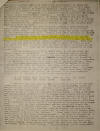
|
3.
8 June 1932.
Report by G. R.
Heath, Kaukira, Honduras, "A
Visit To Brus and Other Places," p. 3.
" . . .
Meanwhile, on Monday 23rd, Leo Mueller
and James Marley, at their own
suggestion, crossed over the lagoon to
Mukabila, 12 miles or more away, and
walked the further 2 miles to Butukamaya
(Butuk Bar). We had intended to go
together by river; but this proved to be
a very unpractical waste of time.
Butukamaya is a larger settlement than
Brus (45 houses in Brus; houses in
B’maya were not counted). But it
is very isolated. The people
welcomed the visitors. On Monday
afternoon they had 40 at the services;
at the three services on Tuesday 90, 60,
and 110 respectively; Wednesday morning
40. Leo reports even greater
enthusiasm than in Brus, which
corroborates the impression I received
in 1930. The children were
especially eager to learn. ¶
On Friday 27th we left Brus at 2 a.m.,
hoping to make Butukauas before night;
but this proved impossible, and we had
to camp on the Kipani gravel-beach.
We shall not readily forget the Kipani
mosquitoes. But our mosquito-bars
were good. Leaving soon after
moonrise, we reached Krupunta at
daybreak, when Leo and I left the boat
and visited in the villages. At
Krupunta Betty, a former sukia, has
given up her sorcery, and is very
anxious that the demons “shall not show
her things anymore.” People from
all three villages agreed to gather at
Butukauas. That evening there were only
24 at the service; but on Sunday in
spite of much rain there were 50.
We had to keep two long services, at
which Leo and James assisted. Here
too the people begged for a catechist to
live among them. ¶ Leaving
Butukauas at 7:30 on Monday 30th, we did
not reach the Warunta Lagoon till
nightfall. We found a planting
camp at Awrata, and slept there.
It took us most of the next day to get
to Palkaka, which is the largest
settlement on Tansen Island, and itself
is situated not on the edge of the
Tansen Lagoon, but on the great
Caratasca. We had 50 persons at
service that night, and 25 the next
morning. Many of the inhabitants
were away from home. Across the
island it is an easy walk to the other
settlements, some being only a mile and
a half away, but there was no time after
our arrival to notify them. We
reached home in the late afternoon of
June 1st. Thus we were away
fifteen days and only touched five
places; but we tried to do more
intensive work at most of them than is
possible on a casual visit. ¶
IT IS PLAIN THAT SOMETHING MUST BE DONE
FOR THOSE LIVING BEYOND THE BUTUX RIVER.
But how: ¶ I adhere to my
point made in 1930 that there should be
an ordained missionary for that
district. At present we have none
to send. Could Leo Mueller do most
of the work? Perhaps; for he is
abler and more independent and
self-reliant than most of the
catechists. BUT if he were
stationed at Brus it would be necessary
for the Warden to make a definite and
binding signed agreement with the United
Fruit Company for the payment of Leo’s
salary at the commissary at Bacalar;
because for me to send over a special
messenger from here would cost far more
than it would be worth. And
probably either the Warden or the
Superintendent would have to go
personally to Puerto Castilla and
Bacalar to inaugurate the arrangement.
This may seem exaggerate; but one should
not forget the trouble I had in Trujillo
last year. To pay any Indian
brother four to six months’ salary in a
lump sum would be ruinous; not even the
best of them knows how to estimate,
economise, or save up for the future,
with the possible exception of Br.
Coleman. There would also at first
be difficulties at Brus about
planting-ground. The town is
situated on a low, muddy, barren
savanna, which dies up only in the dry
season. The lower Butuk bears good
bananas, but is subject to destructive
floods. The land on the Sikri
Creek is poor; a little better on the
Twas; good on the Silakunta, which
however is rather far off; very good on
the Plantain River, which is still
further. This difficulty is not
insuperable. . . . "
|
|
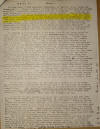
|
4.
8 June 1932.
Report by G. R.
Heath, Kaukira, Honduras, "A
Visit To Brus and Other Places," p. 4.
" . . .
Failing Brus, I had suggested Paptalaya,
or better, as it turns out, Butukauas.
There is plenty of food there even at
this time of general scarcity.
Plantation grounds are good and
accessible. There are not any
mosquitoes, so that the place is fairly
healthy. But above Waksma and
Ausadakban the Indian settlements are
few and small. And the refugees
from the Wangks cling to the
neighbourhood of the Wangkibila, about
five day’s journey from the Butukauas;
neither are they always there – they
come and go. The average journey
to Brus and Butukamaya is long; not so
long indeed to go, but long to come
back. One cannot return from
Butukamaya in under two days; and in
flood time it would take more. So
while Butukauas has its appeal, it would
not after all be a really practical
based for serving the more distant
districts that call for help. ¶
In PALKAKA the famine seems to be worse
than at any other point in this region.
Miskito people are the same everywhere;
they will not cultivate the soil, only
burn virgin forest and plant.
Dakura land ploughed and taken care of
would be by no means worthless; Br.
Newton Wilson proved that long ago.
But I am not sure that Palkaka is as
good as Dakura. There are planting
grounds at Awrata; on the Ibantara
River; and on the Wahamuk Creek; but
they are very far away; and a catechist
who attends to his reading-classes and
instruction-classes would not have time
to go there. Leo, however, thinks
that the situation is not hopeless, but
knees further investigation.
Further, he says that he would not find
it so hard to visit Butukamaya by way of
he inside route from Palkaka to
Twakunta, and a fourteen miles’ walk
along the beach. From Butukanaya
to Brus he now knows that way, and
thinks he could visit both of these
places more readily from Palkaka than
from Butukauas. I know, however,
that he would not make Butukamaya from
Palkaka in less time than two days and a
half. For myself, I would have to
say frankly that I can no longer manage
these long beach journeys either on foot
or on horseback, though I might attempt
one in an exceptional case of special
need. A younger man, especially a
native, might manage them well.
THE PEOPLE OF PALKAKA, although not as
eager in their manner as those of Brus
and Butukamaya, are yet the only larger
community in the Caratasca region which
has shown itself willing to walk to
another place to hear the Gospel, as
they did, in rainy weather, when I was
at Uhunuya in December. ¶ On
the whole, therefore, if the next step
forward it to be taken by an evangelist,
I recommend after all that he be
stationed at Palkaka. BUT this
matter of his plantation should be
settled before he attempts to reside
there. AND FURTHER, Palkaka is not
real solution of the urgent problem of
Brus and Butukamaya; it is only perhaps
a step toward that solution. THAT
PROBLEM MUST NOT BE SHIRKED BY US.
¶ I did not on this occasion go on
to the districts of Ras and Iban.
If Leo can be spared again in September,
we might perhaps try to get so far.
Their problem is connected with that of
Brus. Since my return I hear that
there is some prospect of a modest
industrial development in that region.
Above in connection with Butukamaya it
should have been mentioned that those
people in spite of their eagerness have
no real leader, nor anyone who can read.
Their natural leader, Robert Trapp, is
involved in a peculiarly inexcusable
piece of polygamy. His real wife
seems to be a woman of character and
backbone. The Butukamaya people
supplied food and horses to the
preachers gladly and without charge.
¶ Why do I not urge those who are
interested to come and stay in Kaurkira
for a time? Because the famine is
sore in the land. Butukauas is the only
neighbourhood where there is plenty to
eat. At Kaurkira some families and
individuals have done really good, and
will reap the fruits of it if their
produce is not stolen. Others have
been lazy. Most of the men have
now gone away to try to earn some money
in the banana farms; for money, clothing
and other commodities are very scarce."
|
|
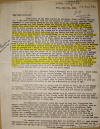
|
9 June 1932.
Letter from A. O.
Danneberger, Yulu, Nicaragua, to
Miss Kreitlow, USA.
"Dear Miss
Kreitlow:- ¶ Your letter of
May 26th reached me yesterday.
Thank you very much for it. I can
quite understand that you are anxious to
return to your work and I had consented
to your coming whenever you are ready to
do so, although others have advised
against it. Only lately, since the
bandits had come to Sandy Bay and to
Sisin, from where they had planned to
proceed to Yulu, I let myself be
persuaded, that it would perhaps be
better to wait until the election is
over. But, I doubt, that the
election will bring any change and we
missionaries had better make up our
minds that the days of quiet laboring
for our Master are over and that in
future we will have to face dangers and
persecutions, as is the case in other
missionfields in these latter days.
Anyone who is prepared to endure for His
Master’s sake and has the faith that His
Will will be done, should be allowed to
take up the work she or he feels called
to do. It is a fact that in every
case where a missionary or evangelist
has been in danger here in this country
he was given sufficient time to seek a
place of safety. I have written to
Br Shimer yesterday, “Miss Kreitlow
believes that she has trustworthy
friends amongst Indians and Spaniard who
will help her in case of trouble and I
think we should leave it to her whether
she should return or not. So far
Kruta has not been molested and perhaps
she is right in saying, she should never
have left the place. It is
impossible for you and for me to tell
anybody what do in these days of
uncertainty and danger. Everybody
must ask for himself as best as he can
under the Spirit’s guidance”. Of
course the work is not only on account
of the many rumors. Only a day or
two ago a Spaniard from here told me
that he had heard that my name, together
with others from here, was on the black
list and that I, therefore, should not
stay in Yulu. We are very careful.
A suitcase with the most important
church and station books is kept ready
close by the door every night. I
have been assured that we will be
notified of any approaching enemies.
I am writing this so that you should
know the whole truth. ¶ I
did send you a Standard Fruit &
Steamship Co.’s time table. Their
boats run by way of Havana and Colon to
Puerto Cabezas. The boats are much
bigger, faster and cleaner than those
that go to Bluefields. I would
advise you to take a boat to Puerto
Cabezas. When you make your
arrangements you might mention the fact
that the manager of the company here in
Puerto Cabezas has agreed to give all
Moravian missionaries traveling to and
fro a reduction of fares of 25%. ¶
I know you won’t mind my giving you the
advice to bring out as few things as
possible. We are all developing
the “grass hopper” spirit, as Jack
Coleman calls it, and with this spirit
it is best to be burdened with as few
things as possible. ¶ Ethel
went back with her step father when he
returned from the school for evangelists
which we kept here in Yulu during April.
He wrote me the other day that they
spent two weeks camping on the river on
account of the bandits which had passed
through Sackling on their way to Sandy
Bay. ¶ The economical
condition along the coast is very bad.
Everywhere the church attendance goes
back because the people, and especially
the children, have no clothes.
Also food is very short and many
actually suffer from starvation.
Yulu has enough and to spare. We
are able to continue our work in spite
of shortage of money and clothing.
The Adventist school has gone down to
almost nothing. The teacher and
preacher cannot hide his sin any longer,
and the girl with whom he is living, one
of the members, will soon present him
with a child. He is now married to
her, but has been dismissed by
headquarters. Father and brothers
continue the work. ¶ We
receive very encouraging news from the
children. Will you pass through
Bethlehem? Flora joins me in
cordial greeting to you. We will
both remember you in our prayers and ask
the Lord to help you to the right
decision. ¶ Sincerely yours,
. . . "
|
|
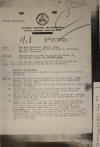
|
10 June
1932.
Supplementary operations report for
Record of Events, May 1932, for Neptune
Mine, Col. L. L.
Leech, Bluefields, p. 1.
"Supplementary
operations report for Record of Events,
May, 1932, for NEPTUNE MINE. ¶
1. The reports listed below arrived
Bluefields too late to be incorporated
in the May Record of Events. ¶
C MILITARY OPERATIONS ¶ 1.
Movements of Patrols, Guardia Nacional,
and other service personnel. ¶
May 11 Guardia and civics combined
patrol returned from TUNKY. Sergeant
GARCIA, Agustin #2318 arrived from
BLUEFIELDS and reported for duty.
¶ May 17 Sergeant GARCIA, Agustin
#2318 and combined Guardia patrol
cleared for Tunky. ¶ May 18
Information resolved that bandits were
at La Ceiba near Limon. Spies were
sent out to localize them.
Sergeant GARCIA and patrol returned from
TUNKY. ¶ May 20 The information
persisted. The bandits threatened
to attack NEPTUNE MINE. We made
ready for the fortification and the
defense of the place. ¶ May
21 Always threatened, I assumed the
movements on both hills and I took place
on hill #1. Lieutenant Gray cleared with
a combined patrol and gains contact with
bandits about two miles southeast.
(See Official report.) Some
bandits run across to other hills nearby
and I opened fire on them with the Heavy
Browning and some rifles. It is
known and believed that the bandits
completely surrounds Neptune Mines on
all sides, and the defense was organized
immediately in case of an attack. . . .
|
|
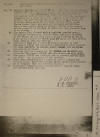
|
10 June
1932.
Supplementary operations report for
Record of Events, May 1932, for Neptune
Mine, Col. L. L.
Leech, Bluefields, p. 2.
" . . .
May 22 Sergeant GARCIA, Agustin #2318
and a combined patrol cleared NEPTUNE
MINE to investigate about a group of
bandits who were said to be at the
bodega Agua Caliente. He returned
and informed me that he found some
recruit footprints. Lieutenant
SOMARRIBA and a combined patrol cleared
in pursuit of the bandits and went
through the vicinities of Agua Caliente,
La Panama Mine, Maria Obande Farm,
Moncada Farm, Aguas Claras (place where
Lt. Gray had contact) and Urruito.
When it was getting dark we couldn’t
follow them anymore and we returned to
the mine to reinforce that place in case
of an attack. ¶ May 23
Lieutenant GRAY cleared with a combined
guardia patrol and gained contact with
bandits about one mile northwest of the
Mines. At the same time a group
attacked El Salto. A new group intents
to attack Hill #1 again and were driven
back. (See my official report).
¶ May 25 Lieutenant GRAY and a
combined patrol cleared to meet
Lieutenant CURCEY and his patrol.
Combined patrols cleared for AGUA
CALIENTE, LA PANAMA, AGUAS CLARAS, and
LA LINEA. All patrols returned. ¶
May 26 Combined patrols cleared for the
BODEGA and EL SALTO and returned.
Lieutenant CURCEY and patrol arrived
from WUANI. ¶ May 27
Lieutenant CURCEY and combined patrol
cleared NEPTUNE MINE for WUANI and in
pursuit of the bandits. ¶
May 28 Lieutenant SOMARRIBA and a
combined patrol cleared and arrive
TUNKY. Lieutenant CURCEY gains
contact with bandits at EL ROSARIO.
(See his official report.) ¶
May 29 Lieutenant SOMARRIBA and combined
patrol cleared TUNKY for NEPTUNE MINE.
Arrived. ¶ L. L. LEECH"
|
|
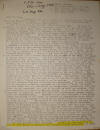
|
15 June
1932.
Letter from G. R.
Heath, Moravian Mission c/o Cabo
Gracias a Dios, to Dr. S. H. Gapp,
Bethlehem PA, p. 1.
|
|

|
15 June
1932.
Letter from G. R.
Heath, Moravian Mission c/o Cabo
Gracias a Dios, to Dr. S. H. Gapp,
Bethlehem PA, p. 2.
|
|
|
|
|
PREVIOUS
NEXT |
|
|
|
|
|
|
|

